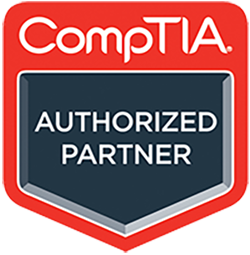Certified Cybersecurity Professional
Subjects
The Certified Cybersecurity Professional is made up of 3 Certifications.
The Computing Technology Industry Association (CompTIA) is the leading provider of vendor-neutral IT certifications in the world. It is considered one of the IT industry’s top trade associations and has issued over 2 million certifications worldwide, in it’s 20 year history.
Each Certification is comprised of numerous courses. The Certification structure is outlined below.
CompTIA A+ is the preferred qualifying credential for technical support and IT operational roles.
- Demonstrate baseline security skills for IT support professionals
- Configure device operating systems, including Windows, Mac, Linux, Chrome OS, Android and iOS and administer client-based as well as cloud-based (SaaS) software
- Troubleshoot and problem solve core service and support challenges while applying best practices for documentation, change management, and scripting
- Support basic IT infrastructure and networking
- Configure and support PC, mobile and IoT device hardware
- Implement basic data backup and recovery methods and apply data storage and management best practices
CompTIA Network+ helps develop a career in IT infrastructure covering troubleshooting, configuring, and managing networks.
- Design and implement functional networks
- Configure, manage, and maintain essential network devices
- Use devices such as switches and routers to segment network traffic and create resilient networks
- Identify benefits and drawbacks of existing network configurations
- Implement network security, standards, and protocols
- Troubleshoot network problems
- Support the creation of virtualised networks
CompTIA Security+ is a global certification that validates the baseline skills one needs to perform core security functions and pursue an IT security career.
- Analyse indicators of compromise and determine the type of malware
- Compare and contrast types of attacks
- Explain threat actor types and attributes
- Explain penetration testing concepts
- Explain vulnerability scanning concepts
- Install and configure network components, both hardware and software-based, to support organisational security
- Use appropriate software tools to assess the security posture of an organisation
- Troubleshoot common security issues
- Deploy mobile devices securely
- Implement secure protocols
- Compare and contrast identity and access management concepts
- Implement identity and access management controls
- Explain the importance of policies, plans and procedures related to organisational security
- Explain risk management processes and concepts
- Follow incident response procedures
- Summarise basic concepts of forensics
- Explain disaster recovery and continuity of operation concepts
- Compare and contrast basic concepts of cryptography
Want more information about the subjects for this course?
Want to know more about this course?
Complete the form and learn about:
- Pricing and payment options
- Start dates
- Subjects
- Study method
- How to get help and contact information
- Everything you need to know before enrolling!
Receive a consultation from a course expert
See student testimonials below
"I found the website easy to use and the contact I received after my enquiry was good. Not too pushy but there if I needed them." - Dimity G.
"All details and info was there and my query was answered quickly." - Soula M.
"Gave me everything I needed and someone called me, pretty much straight away." - Marlon T.
Want to know more about this course?
Get your free course guide now! Complete this easy form and you'll receive a course guide and consultation from Lumify Learn


